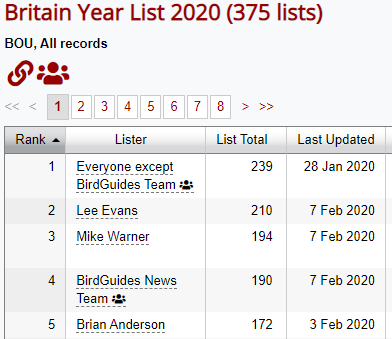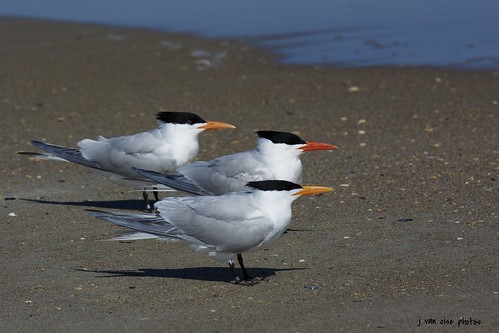BUBO Listing News
We have just launched the ability to combine existing lists with each other on BUBO Listing. This means that if you have entered one or more country lists say, and wish to add records from these to update your World list, you can now do so.
Combining lists works across different taxonomies so you can add AOS records from a North America list into an IOC-based World list for example; because of taxonomy differences you are likely to find some records that cannot be automatically combined and you will be notified of these.
Combining lists works with lists that you have already created. If you wish to create an entirely new list based on records from an already existing one, Create New List already does exactly that. You can only combine lists one at a time, so if you want to combine your British list and your North American list into your World list for example, you could first combine the British list with your World list, then separately combine your North American list.
If a species does not exist on the list you are copying to, but is recognised by the authority, it will be added. If the species is already on the list then the details (date, location etc.) will be taken from the earlier of the two records from the lists being combined.
To combine a list with another:
- Select the Combine Lists option from the user menu when logged in.
- First select the primary list, i.e. the one to which you wish to add records, from the table.
- Then select the secondary list, i.e. the one which contains the records you wish to combine with the primary list, from the dropdown selection below the table.
- You will be asked to confirm before the combining is done. The operation is complicated and cannot be undone, so do check carefully (e.g. to see that you have primary and secondary lists the correct way round) before going ahead.
- You are also given the option to add a note to the location of each record. This is particularly useful when combining records with a World list since you can ensure that the country of the secondary list is carried across to the primary. For example, if I was combining a Norfolk county list into my World list I may have an existing species record with a location of "Cley". This location alone would be fairly meaningless on a World list, so I could add a location note of "Norfolk, England": the resulting World list entry would show as "Cley [Norfolk, England]".
- After combining you will be shown (and emailed) those species that have been copied. You may have some manual updates to make to the new primary list, particularly where taxonomies differ.
Note that if a species on the secondary list has been split or lumped on the primary list, it will not be copied. We recommend you process all taxonomic updates on the secondary list before combining lists.
If you encounter any problems at all then please Contact Us. As always we'd love to hear your feedback too - a posting in the forums is best for this so that other BUBO Listers can add their comments.
We have just launched 'group lists' in BUBO Listing. A few people have created accounts in the past for a group, but this is not something we officially permitted, for a couple of reasons:
- We have always insisted on real person names as we believe this is important for the openness in listing that we wish to see
- Group accounts are misleading and annoying for listers when viewing rankings tables: imagine being a high lister near the top of a rankings table for somewhere, only to find a combined list for a group of ten individuals above you!
We now support group lists in a better way for everybody.
- Any group lists are excluded from rankings tables by default, so these tables will always be for individual lists
- When viewing a rankings table, if group lists have been added, you will see a 'groups' icon that will reload the table with group lists displayed

- Group lists will be shown with the 'groups' icon beside their name
- Clicking the main 'groups' icon again will reload the table without the group lists

- If a particular list doesn't have any group lists yet, the groups icon will not be shown, so you will just see the list 'link' icon as currently.
Group lists are ideal for a society wishing to include the full species list for their recording area, whether this is a formal society or an informal group of watchers at a patch. For example, the rankings table for a local patch could then show the number one lister as the group list, containing all species ever recorded on the site, including historical records. This quickly shows individual listers how many more species they need to find! They are also ideal for tours, whether for a few friends who regularly travel together and wish to keep an overall list from their trips, or tour companies (like the just launched Bubo Birding!)

If you wish to create a group account then sign up as usual but select 'Yes' to the 'Group Account?' question. Any lists that a group account creates will automatically be treated as group lists. Alternatively, if you have already created a group account, or notice any lists that others have created before and are not bring treated as group lists, let us know and we will update them.
The IOC World List has now been updated to the latest published version 10.1 from January 2020.
The new list includes the newly described Alor Myzomela and Spectacled Flowerpecker, but Deignan's Babbler and Hoogerwerf's Pheasant are no longer recognised as valid species. Newly split species this time around include Western/Eastern Black-eared Wheatears, West African Crested / Royal Terns, Maghreb/Tawny Owls, Sunda/Collared Owlets, Butterfly/Festive Coquettes, Cryptic/Graceful Honeyeaters, Himalayan/Swinhoe's (Striated) Prinias, Deignan's/Burmese/Annam (Brown) Prinias and Island/Numfor/Biak Leaf Warblers. Finally, v10.1 sees a re-entry by that old favourite, Hudsonian Whimbrel, which has been split, then lumped, and now split again (for how long??)
Regional or country lists based on IOC, such as the IOC Western Palearctic list, have also been updated.
We now automatically apply these updates where we can, and in other cases you will be prompted for any taxonomic changes to address yourself.
BUBO Listing currently supports more than 200 different authorities and countries. Keeping these up to date is a major task, particularly if the official authority themselves does not frequently publish updates to their lists. We would love some help from anyone with a particular interest and local knowledge in a country or region. For example, if you are aware of new species additions to a country or state we can allow you to add them immediately to the appropriate checklist in BUBO Listing, so there is no more waiting for us to get around to it ourselves!
In addition many official authorities don't keep up with taxonomic changes which are published regularly by the main authorities, e.g. IOC and eBird/Clements at world level. This is frustrating for listers when, for example, they visit a country where the latest 'official' list uses a taxonomy that differs from their preferred world list taxonomy. In these cases we will try to either offer an alternate taxonomy based on either IOC or Clements, or pre-empt taxonomic changes on the official authority.
If you wish to help out with making checklist changes for BUBO Listing, please Contact Us and tell us which countries or regions you would like to contribute to.
You will have noticed a new look to BUBO Listing. Everything should work as before but with a few changes other than the new design:
- You no longer need a username. Instead you can log in with your email address, or your existing username. Forgotten usernames and passwords are a very common support query for us, so hopefully this will be easier for everyone in the future!
- The menu of options when you are logged in, to view My Lists, Create New List etc., is now part of the main menu at the top. If you can't see My Lists in this menu, then you need to log in. The login form has now moved to the top right.
- New functionality includes checking the Top Blockers for any list!
Thanks to the brilliant Gyr Crakes for the updated BUBO logo!
If you notice any problems with the new site then please contact us.



